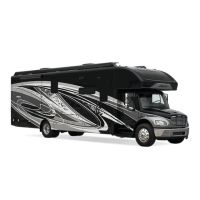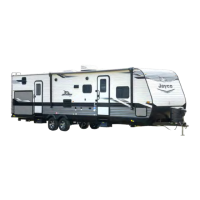91
5. Move the valves to the “Sanitize/Winterize Lines” position. The low point drains must
be closed for the antifreeze to siphon through the lines.
6. Attach the short hose supplied with the motor home to the fresh water connection inlet
and insert the other end of the hose into a gallon container of RV antifreeze. To assist
the siphoning process, put the container on a surface approximately two feet above
ground level.
7. Turn the water pump ON. Antifreeze will be drawn into the water lines.
8. Open the hot water line on all the faucets (kitchen, lavatory, shower and outside show-
er) until RV antifreeze begins to ow continuously.
9. Close the faucet hot water lines and repeat with the cold water lines on all the faucets.
Flush the toilet a couple of times until you see antifreeze in the bowl.
10. Remove the short hose from the container of RV antifreeze.
11. To prevent staining, wipe the RV antifreeze out of the sinks, shower (or tub) and toilet
using a soft, dry cloth.
If needed, contact your RV dealer for assistance.
If your motor home comes equipped with a macerator system, it can retain water in the
exible hose, the dump connector attached to the ex hose, and the macerator box and pipe.
Pour antifreeze into the dump connector and into the 1-1/2-inch exible hose. Then raise the
hose allowing the antifreeze to run back down to the macerator pump. Return the ex hose
and dump connector to the storage box.
Water can accumulate in the exible hose and dump connector of the mac-
erator system. Antifreeze must be added to the macerator system to prevent
freeze damage.

